
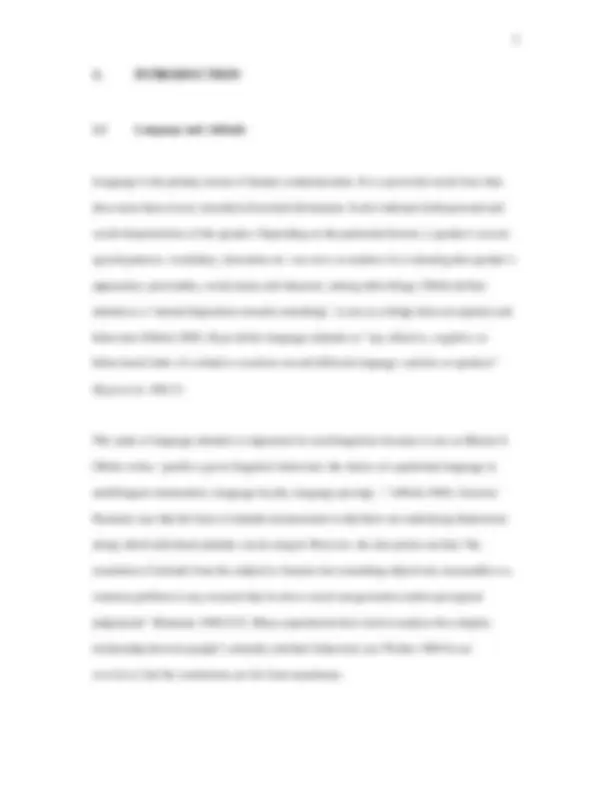
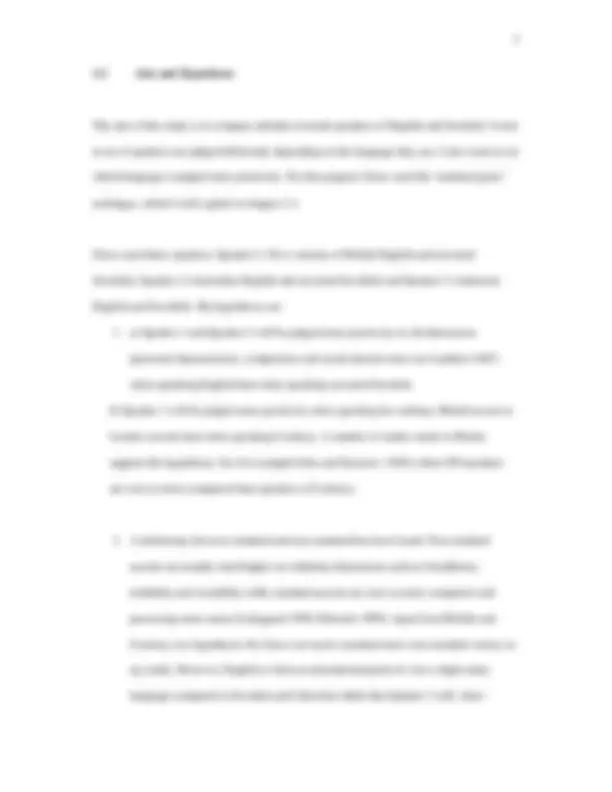
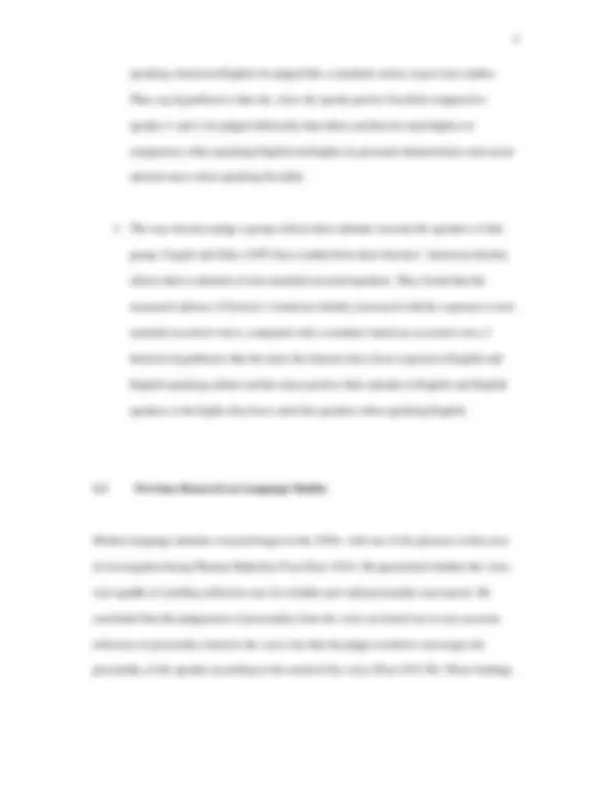
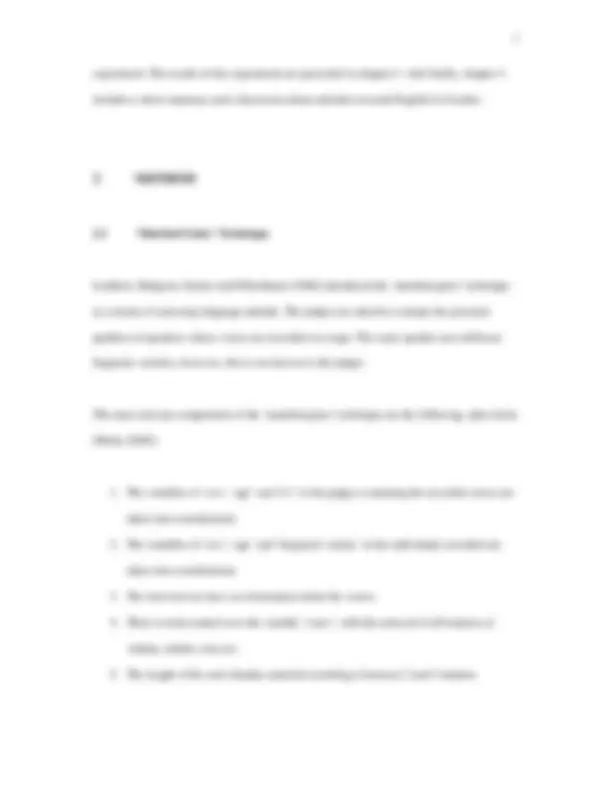
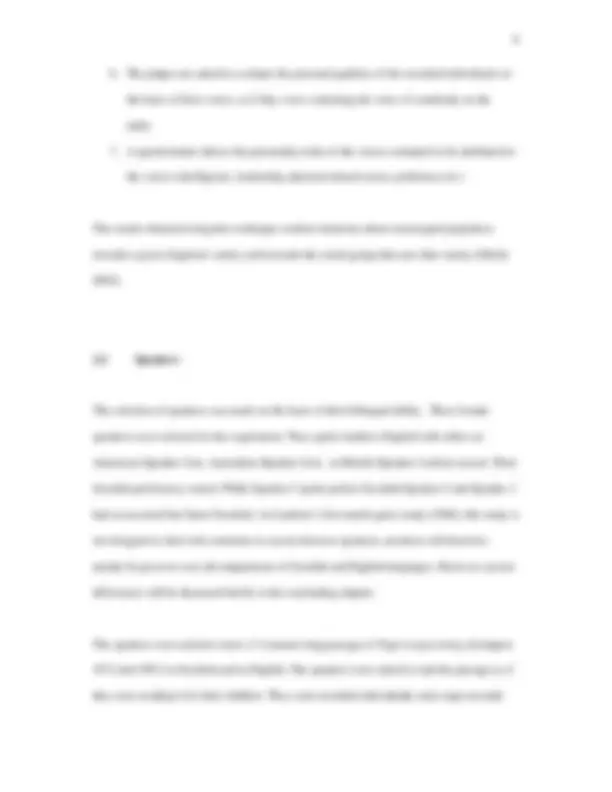

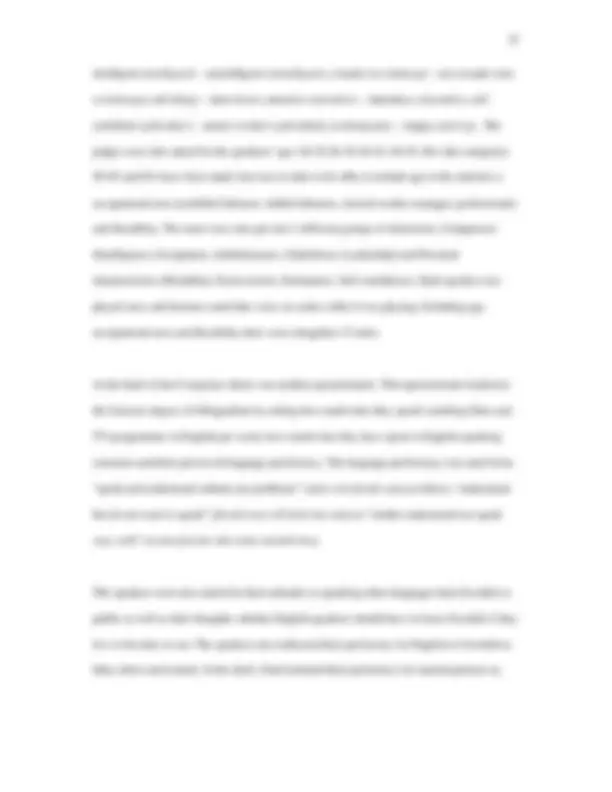
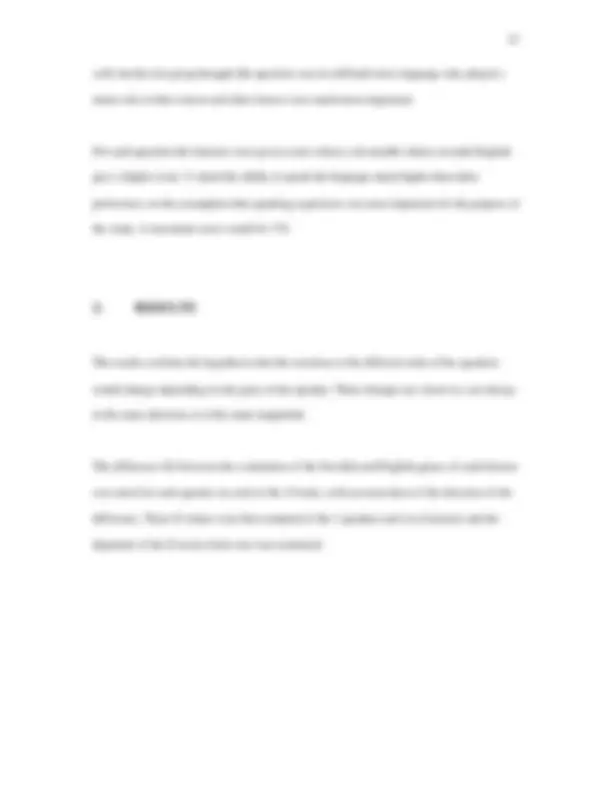
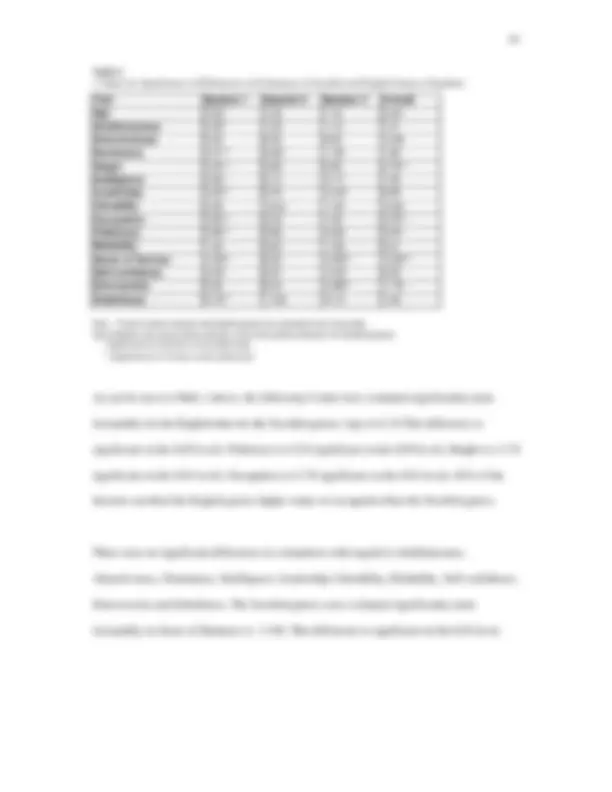
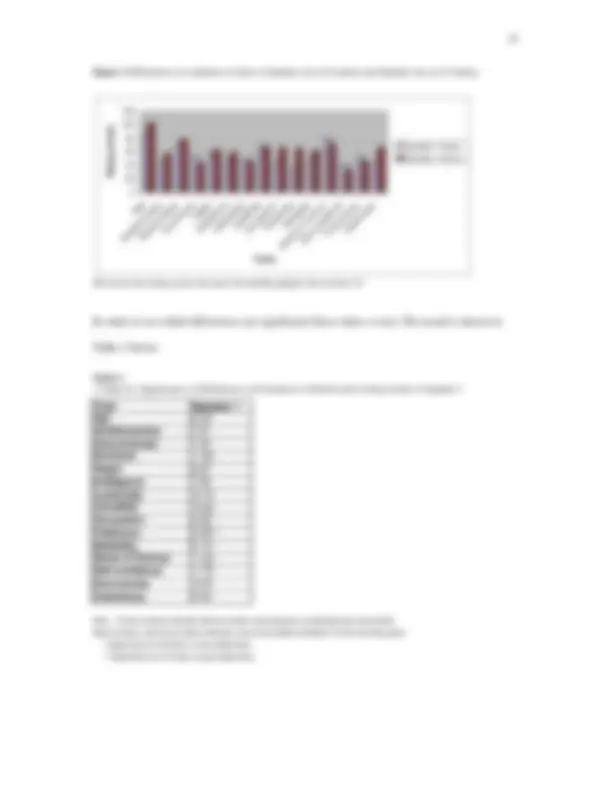
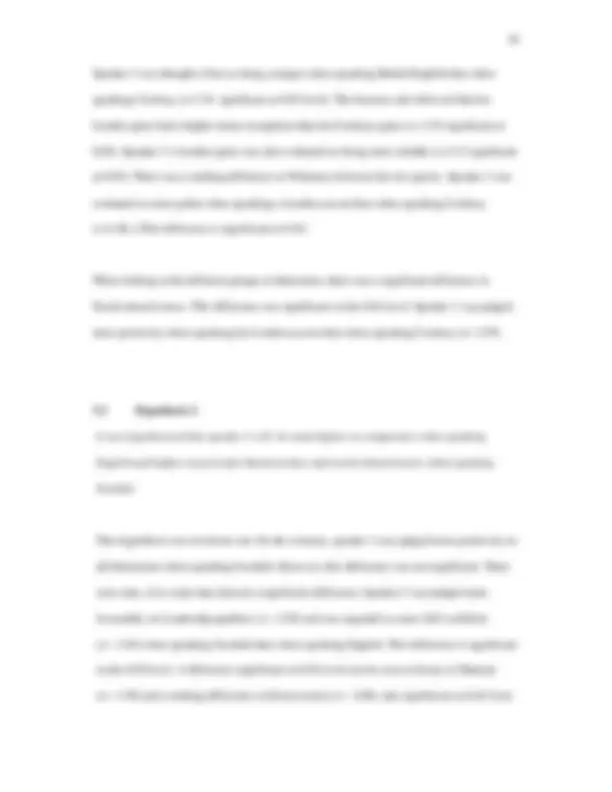
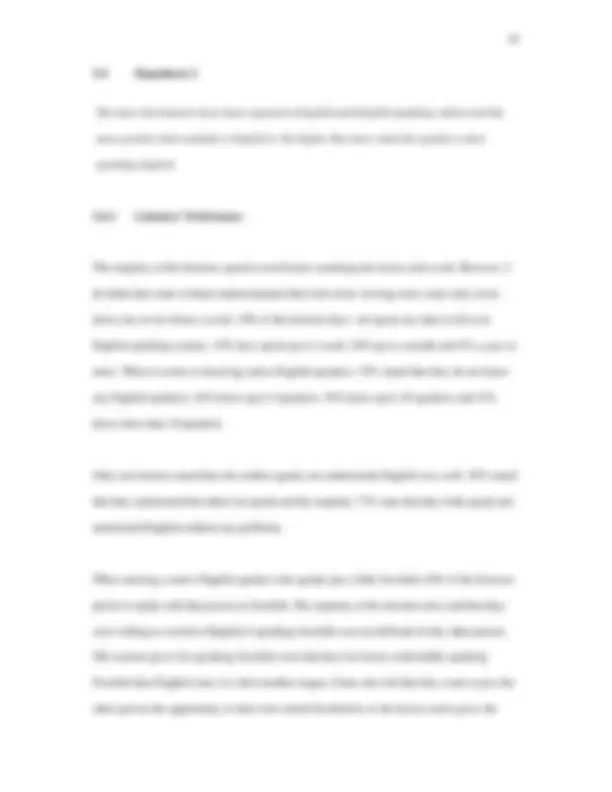
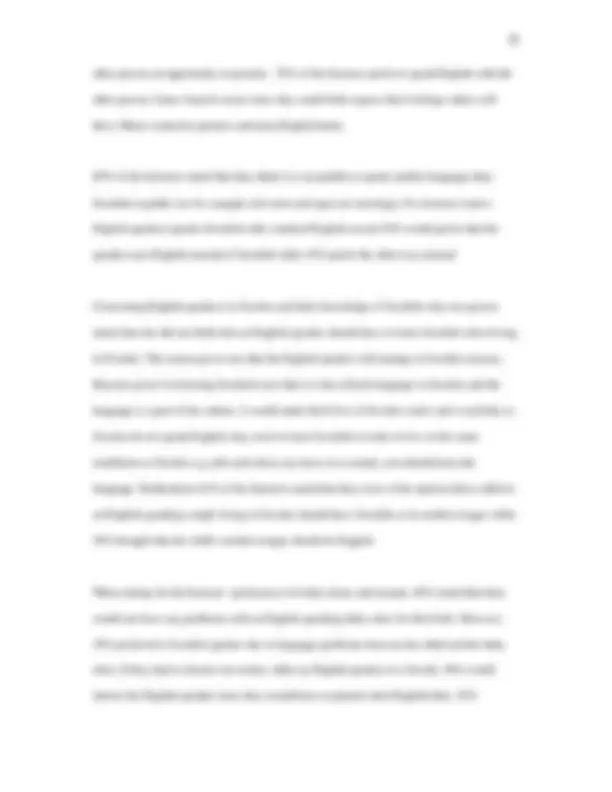
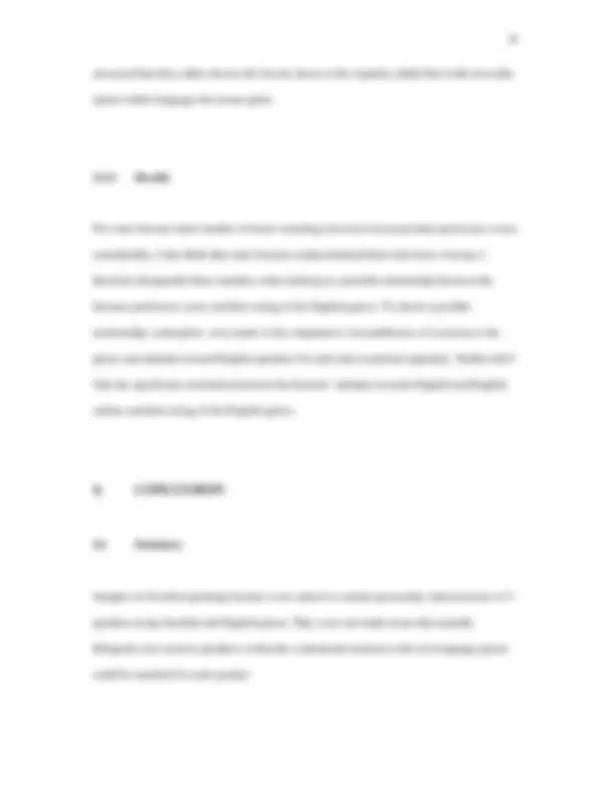
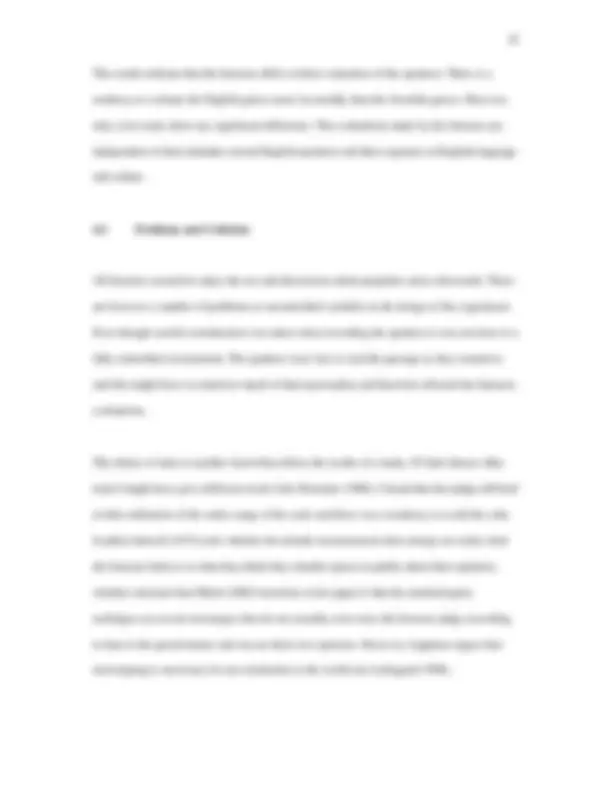
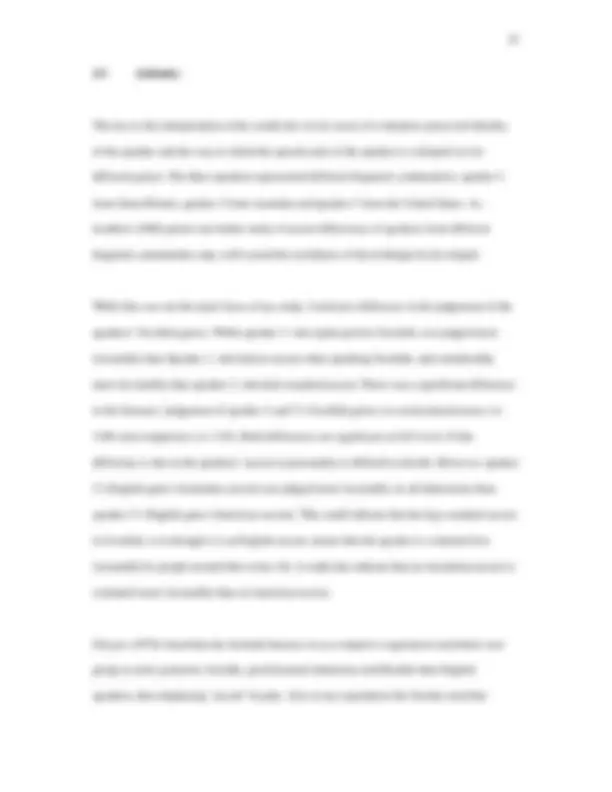
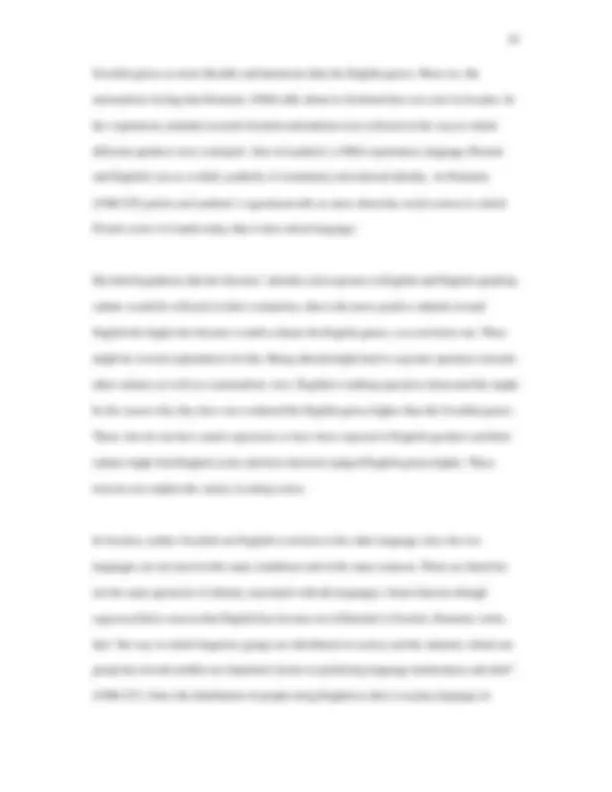

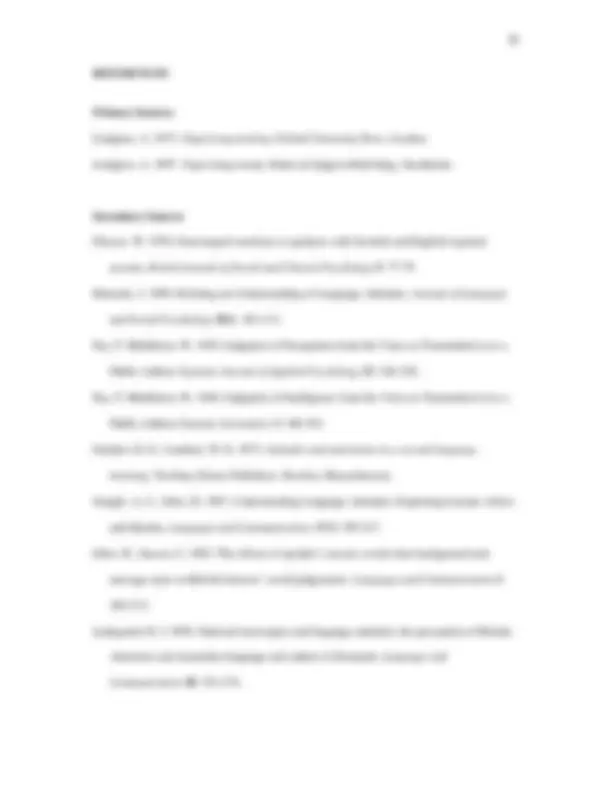
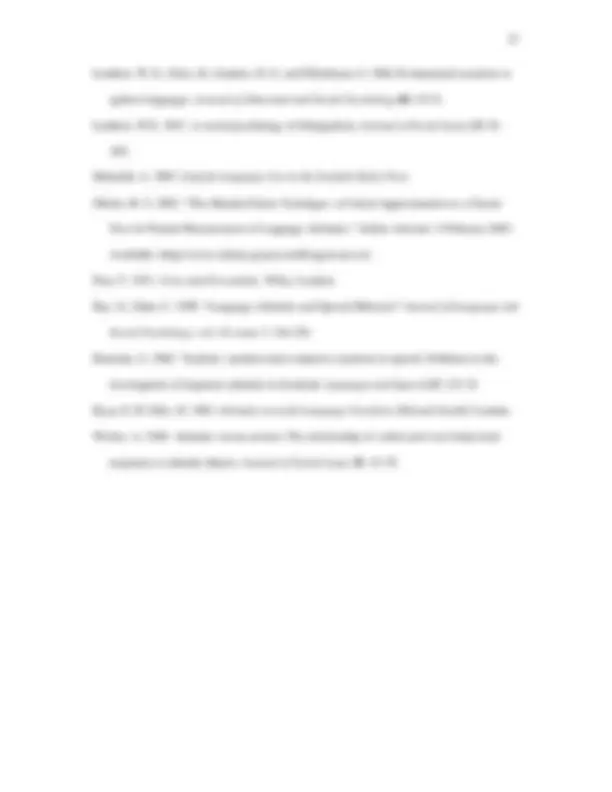


Study with the several resources on Docsity

Earn points by helping other students or get them with a premium plan


Prepare for your exams
Study with the several resources on Docsity

Earn points to download
Earn points by helping other students or get them with a premium plan
Community
Ask the community for help and clear up your study doubts
Discover the best universities in your country according to Docsity users
Free resources
Download our free guides on studying techniques, anxiety management strategies, and thesis advice from Docsity tutors
Language and Attitude The study of language attitudes is important for sociolinguistics because it can, as Marina S. Obiols writes: 'predict a given linguistic ...
Typology: Study notes
1 / 28

This page cannot be seen from the preview
Don't miss anything!





















Linda Melander English C-essay Högskolan Dalarna April, 2003 Supervisor: U. Cunningham
1.2 Aim and Hypotheses
The aim of this study is to compare attitudes towards speakers of English and Swedish. I want to see if speakers are judged differently depending on the language they use. I also want to see which language is judged more positively. For this purpose I have used the ‘matched guise’ technique, which I will explain in chapter 2.1.
I have used three speakers: Speaker 1 (Two varieties of British English and accented Swedish), Speaker 2 (Australian English and accented Swedish) and Speaker 3 (American English and Swedish). My hypotheses are
speaking American English, be judged like a standard variety in previous studies. Thus, my hypothesis is that she, since she speaks perfect Swedish compared to speaker 1 and 2, be judged differently than them and thus be rated higher on competence when speaking English and higher on personal characteristics and social attractiveness when speaking Swedish.
1.3 Previous Research on Language Studies
Modern language attitudes research began in the 1930s with one of the pioneers in this area of investigation being Thomas Hatherley Pear (Pear 1931). He questioned whether the voice was capable of yielding sufficient cues for reliable and valid personality assessment. He concluded that the judgements of personality from the voice are based not on any accurate reflection of personality found in the voice, but that the judges tended to stereotype the personality of the speaker according to the sound of his voice (Pear 1931:30). These findings
The most representative for indirect types of methodology is the matched guise technique. The first “matched guise” study that examined language attitudes was performed by Lambert, Hodgson, Gardner and Fillenbaum (1960). They examined reactions of English and French speakers in Montreal to English and French guises. They found that both English and French speaking listeners rated English speakers as being higher status. This ‘matched guise’ study has served as a model on which the vast majority of subsequent language attitude studies are based.
Since then a vast amount of language studies have been performed. A more recent example is Romaine (1980) who has looked at how speakers were judged depending on context, each reading a text and speaking casually. She also describes some of the difficulties involved in conducting language evaluation tests in Edinburgh. Another is Cargile and Giles (1997) looks at the effects of a Japanese speaker’s foreign accent, the strength of the foreign accent, the fluency of his speech and the aggressiveness of his message on Anglo-American listeners’ mood state and American identity. Ray and Zahn (1999) who looked at attitudes in New Zealand toward a New Zealand English speaker and a Standard American English speaker, where the speakers altered levels of pitch variation and rate.
1.4 Outline of the Study
In this introductory chapter I have presented the topic of the study, stated its primary aims and hypotheses and looked at previous research on language attitudes. Chapter 2 presents the method used, “matched guise technique” as well as the speakers and the listeners chosen to participate in this study. It also includes a detailed description of the procedure of the
experiment. The results of the experiment are presented in chapter 3. And finally, chapter 4 includes a short summary and a discussion about attitudes towards English in Sweden.
2.1 ‘Matched Guise’ Technique
Lambert, Hodgson, Garner and Fillenbaum (1960) introduced the ‘matched guise’ technique as a means of assessing language attitude. The judges are asked to evaluate the personal qualities of speakers whose voices are recorded on a tape. The same speaker uses different linguistic varieties, however, this is not known to the judges.
The most relevant components of the ‘matched guise’ technique are the following, taken from Obiols (2002):
was used for all recordings. As an additional “experiment within an experiment”, Speaker 1, was presented to the judges in three guises: one in which she read the passage in Swedish and two other guises in English speaking two different British accents (cockney and another London accent). The other two speakers were heard twice, once in Swedish and once in English. Seven samples were thus obtained. They were then edited into random order and adjusted so that no two samples from the same speaker would be adjacent. All disturbing noise was removed from the recordings and the samples were recorded on a compact disc.
A “filler” voice in English was placed in first position, used when explaining the procedure, followed by a control sample in Swedish, used as a “filler” voice and for practice for the listeners. It was then followed by the seven experimental samples. Only evaluational reactions to the matched voices were examined.
2.3 Judges
The voluntary participants who acted as judges were fairly homogenous in terms of social background. They all, at the time of the study, lived in Falun, Sweden and were members of the same church. There is no intention to make any claims about the representativeness of the sample for any larger group. The group of listeners comprised 28 people. Both sexes were equally represented. The speakers’ ages varied from 25 to 35. All listeners were born in Sweden and used Swedish as their primary language both at work and in social contexts. The listeners came in groups of three to eleven to my apartment to listen to the recordings.
2.4. Procedure
A passage of about 2 ½ minute taken from the book Pippi Longstocking (Lindgren 1972 and
The study consisted of two parts: (1) a language attitude experiment (using the principles of the ‘matched guise’ technique, Lambert 1960), followed by (2) a partly closed, partly open- ended questionnaire in which the listeners were asked to answer questions about their language proficiency, how accustomed they were to English and English speakers and their attitudes to English. The questionnaires were tested on a test group before using them in the experiment group.
The listeners who acted as judges were told they were taking part in an experiment to study what could be discovered about a person on the basis of a sample of speech. As in Lambert’s study (1960) the speakers were reminded of the common phenomenon of having a voice on the radio summon up a picture in the listener’s mind of the person speaking. The listeners were told that the two languages were used to give a greater scope to the experiment and
intelligent ( intelligent ) – unintelligent ( ointelligent ), a leader (en ledartyp ) – not a leader ( inte en ledartyp ), tall ( lång ) – short ( kort ), attractive (attraktiv ) – charmless ( charmlös ), self- confident ( självsäker ) – unsure ( osäker ) and orderly ( ordningsam ) – sloppy ( slarvig ). The judges were also asked for the speakers’ age (18-25,26-35,36-45, 46-55, 56+ (the categories 56-65 and 65+ have been made into one in order to be able to include age in the statistics ), occupational area (unskilled labourer, skilled labourer, clerical worker manager, professional) and likeability. The traits were also put into 3 different groups of dimension, Competence (Intelligence, Occupation, Ambitiousness, Orderliness, Leadership) and Personal characteristics (Reliability, Extroversion, Dominance, Self-confidence). Each speaker was played once and listeners rated that voice on scales while it was playing. Including age, occupational area and likeability there were altogether 15 traits.
At the back of the 8 response sheets was another questionnaire. This questionnaire looked at the listeners degree of bilingualism by asking how much time they spend watching films and TV-programmes in English per week, how much time they have spent in English speaking countries and their perceived language proficiency. The language proficiency was rated from “speak and understand without any problems” (talar och förstår utan problem) , “understand but do not want to speak” (förstår men vill helst inte tala) to “neither understand nor speak very well” (varken förstår eller talar särskilt bra).
The speakers were also asked for their attitudes to speaking other languages than Swedish in public as well as their thoughts whether English speakers should have to learn Swedish if they live in Sweden or not. The speakers also indicated their preference for English or Swedish as baby sitters and tenants. In the draft, I had included their preference for marital partners as
well, but the test group thought this question was too difficult since language only played a minor role in that context and other factors were much more important.
For each question the listeners were given scores where a favourable choice towards English gave a higher score. I valued the ability to speak the language much higher than other preferences on the assumption that speaking experience was most important for the purpose of the study. A maximum score would be 170.
The results confirms the hypothesis that the reactions to the different traits of the speakers would change depending on the guise of the speaker. These changes are, however, not always in the same direction or of the same magnitude.
The difference (D) between the evaluations of the Swedish and English guises of each listener was noted for each speaker on each of the 15 traits, with account taken of the direction of the difference. These D values were then summed of the 3 speakers and over listeners and the departure of the D scores from zero was examined.
3.1 Hypothesis 1a Speakers 1 and 2 will be judged more positively on all dimensions (personal characteristics, competence and social attractiveness) when speaking English than when speaking accented Swedish. There was no significant difference in the evaluation of Speaker 2 when it comes to the different dimensions. When looking at the separate traits Speaker 2 was evaluated more favourably on Dominance ( t= 2.08) when speaking English than when speaking accented Swedish. This difference is significant on the 0.05 level. On the whole she is evaluated more favourably when speaking English than when speaking Swedish (except for Likeability and Orderliness). However, these differences are not significant. The hypothesis that Speaker 2 would be judged more positively on all dimensions when speaking English was therefore not borne out.
Speaker 1 on the other hand was evaluated significantly more favourably on her English guise. The differences in Dominance ( t= 3.31), Height ( t= 3.34), Leadership ( t= 3.33), Occupation ( t= 3.54), Politeness ( t= 4.90) and Orderliness( t= 3.15) are all significant on the 0.01 level and Age ( t= 2.53), Ambitiousness ( t= 2.25), Intelligence ( t= 2.06) and Self- confidence ( t= 2.29) are significant on the 0.05 level. Only on one trait was she evaluated less favourably in English, namely Sense of Humour ( t —2.50). A clue to the somewhat skewed distribution on Sense of Humour can, I think, be found in a closer examination of Speaker 1’s way of speaking. She pronounced some particular words in a non-standard Swedish way and her “Swedish melody” was, in general, a bit more “singing” than standard Swedish which therefore sounded a bit humorous.
When looking at the different groups of dimension, Competence (Intelligence, Occupation, Ambitiousness, Orderliness, Leadership) and Personal characteristics (Reliability, Extroversion, Dominance, Self-confidence) did not show any significant differences. However, there was a difference, significant on the 0.01 level, on Social attractiveness (Height, Sense of Humour, Politeness, Age, Attractiveness, Likeability). The hypothesis that Speaker 1 would be judged more positively on all dimensions when speaking English was therefore borne out in parts. When looking at the different dimensions she was not evaluated significantly more favourably on all dimensions when speaking English. However, when taking in account the different traits she was judged more positively on all traits when speaking English, except for Sense of Humour.
3.2 Hypothesis 1b Speaker 1 will be judged more positively when speaking her ordinary British accent (a London accent close to RP) than when speaking Cockney.
The differences in evaluation of the traits can be seen in Figure 1 below where the dark colour represents the cockney guise and the brighter the London accent guise :
Speaker 1 was thought of her as being younger when speaking British English than when speaking Cockney ( t= 2.24. significant at 0.05 level). The listeners also believed that her London guise had a higher status occupation than her Cockney guise ( t= 2.55 significant at 0.05). Speaker 1’s London guise was also evaluated as being more reliable ( t= 2.13 significant at 0.05). There was a striking difference in Politeness between the two guises. Speaker 1 was evaluated as more polite when speaking a London accent than when speaking Cockney ( t= 4.48). (This difference is significant at 0.01)
When looking at the different groups of dimension, there was a significant difference in Social attractiveness. This difference was significant on the 0.01 level. Speaker 1 was judged more positively when speaking her London accent than when speaking Cockney ( t= 2.59).
3.3 Hypothesis 2 It was hypothesised that speaker 3 will be rated higher on competence when speaking English and higher on personal characteristics and social attractiveness when speaking Swedish.
This hypothesis was not borne out. On the contrary, speaker 3 was judged more positively on all dimensions when speaking Swedish. However, this difference was not significant. There were only a few traits that showed a significant difference. Speaker 3 was judged more favourably on Leadership qualities ( t= - 2.40) and was regarded as more Self-confident ( t= - 2.02) when speaking Swedish than when speaking English. This difference is significant on the 0.05 level. A difference significant on 0.01 level can be seen on Sense of Humour ( t= - 3.58) and a striking difference on Extroversion ( t= - 4.88), also significant on 0.01 level.
3.4 Hypothesis 3
The more the listeners have been exposed to English and English speaking culture and the more positive their attitude to English is the higher they have rated the speakers when speaking English.
3.4.1 Listeners’ Preferences
The majority of the listeners spend several hours watching television each week. However, I do think that some of them underestimated their television viewing since some only wrote down one or two hours a week. 19% of the listeners have not spent any time at all in an English speaking country, 15% have spent up to a week, 38% up to a month and 4% a year or more. When it comes to knowing native English speakers, 15% stated that they do not know any English speakers, 42% know up to 5 speakers, 19% know up to 10 speakers and 23% know more than 10 speakers.
Only one listener stated that she neither speaks nor understands English very well. 19% stated that they understand but rather not speak and the majority 77% state that they both speak and understand English without any problems.
When meeting a native English speaker who speaks just a little Swedish, 65% of the listeners prefer to speak with that person in Swedish. The majority of the listeners also said that they were willing to switch to English if speaking Swedish was too difficult for the other person. The reasons given for speaking Swedish were that they feel more comfortable speaking Swedish than English since it is their mother tongue. Some also felt that they want to give the other person the opportunity to show how much Swedish he or she knows and it gives the